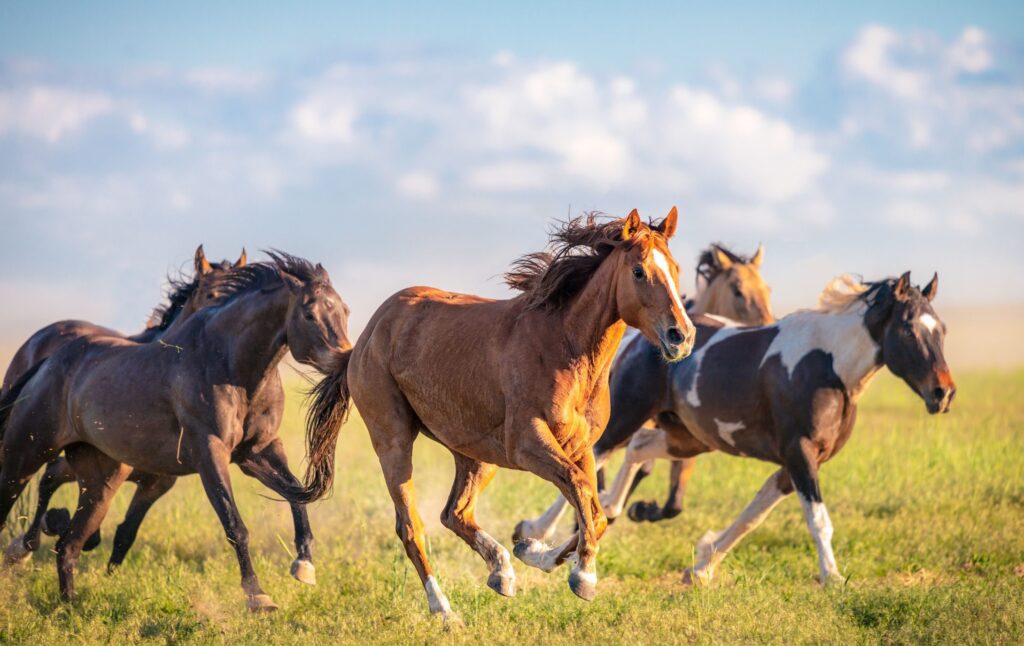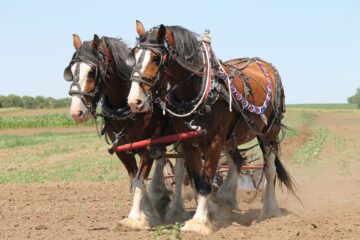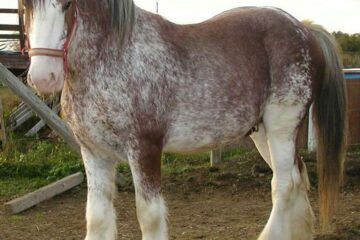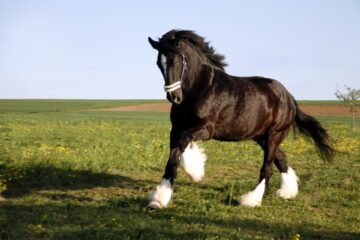
Introduction
Mustang horses have made an unmistakable impression on the American environment due to their rich history and irrepressible spirit. These iconic emblems of liberty and resilience have captured the hearts of people all over the world. In this essay, we will delve into the intriguing world of Mustang horses, tracing their history, analyzing their distinct qualities, and comprehending their importance in today’s society.
A Glimpse into History
The Wild Origins
Mustang horses first appeared in the Americas centuries ago, when Spanish explorers took their equine companions with them. These horses eventually escaped and adapted to life in the wild, giving rise to the Mustang breed.
Roaming the Untamed West
Mustang horses formed an important part of the American frontier throughout the 19th century westward development. Their untamed temperament and endurance made them indispensable for livestock, transportation, and exploration.
A Symbol of Freedom
Mustangs have long symbolized the wild energy of the American West. They became symbols of liberty, symbolizing the rough independence of the area they traversed.
Characteristics That Define Mustangs
Strength and Adaptability
The survival of Mustangs in adverse conditions demonstrates their extraordinary strength and flexibility. These characteristics have been passed down through generations, making them tough and long-lasting.
Graceful Resilience
Mustangs, despite their untamed roots, have a distinct grace that distinguishes them different. Their flowing manes and tails sway in the breeze, representing their connection with nature.
Diverse Coat Colors
The Mustang breed has a wide range of coat colors, from earthy tones to eye-catching pinto patterns. This variance adds to their allure and highlights the beauty of natural variation.
The Modern Connection
Preserving the Legacy
Mustang conservation efforts have gained momentum in the modern era. Individuals and organizations work intensely to preserve the survival of these living historical artifacts.
Mustangs in the Arts
Mustang horses have a legacy that stretches beyond farms and broad pastures. They have influenced artists, writers, and filmmakers, establishing a lasting artistic impact.
Exploring the Mustang Experience
Mustang Sanctuaries and Tours
Mustang sanctuaries and guided tours provide an up-close interaction with these majestic creatures in their natural habitat for anyone seeking to experience the fascination of Mustangs firsthand.
Adopting a Living Legend
Adopting a Mustang is a wonderful experience that allows people to give a piece of living history a lifetime home. It’s an opportunity to connect with the breed’s history while also contributing to its future.
Types of Mustang
Comstock
A Comstock Mustang is a distinct breed of horse that originated in Nevada’s Comstock region in the late 1800s. These tough horses are well-known for their low-maintenance, easy-care temperament, making them a great choice for ranchers and other rural residents laboring on the harsh frontier.
Comstock mustangs are typically tall and thin, with long legs that allow them to gallop and run at rapid speeds for long distances. Their unique coloring, which includes palominos, bays, and chestnuts, is said to have played a role in their popularity among Comstock ranchers.
Comstock Mustangs are still a revered part of Western tradition and treasured icons of rugged American strength and drive today. Federal law does not classify them as “wild” due to their typical habitat on private property.
As a result, they do not have the same level of protection as Mustangs. Some organizations are attempting to safeguard the Comstock’s.
Pryor Mountain Mustangs
The Pryor Mountain Mustang is a small, compact horse that thrives in Montana and Wyoming’s rough Pryor Mountains. Experts assert that these horses trace their ancestry back to Spanish equines brought to North America by early explorers.
Over the years, the Pryor Mountain Mustangs have acclimated to their challenging mountain habitat, gaining recognition for their agility and endurance.
These wild horses are crucial to the ecology of the Pryor Mountains and attractive tourist attractions. Every year, almost 10,000 people visit the Pryor Mountains to observe these incredible creatures in their natural habitat.
Pryor Mountain Mustangs have a straight, convex shape that tapers to the muzzle. Black/brown, bay dun, bay, black, chestnut, or roan are common colors. Pryor Mountain Mustangs are bright and fearless, with a reputation for long-distance endurance.
Coyote Canyon Mustangs
Coyote Canyon Mustangs are a species of wild horse that roams the Coyote Canyon area in the Sierra Nevada Mountains of California. These mustangs are ancestors of Spanish horses brought to the Americas centuries ago by explorers and settlers.
There are an estimated 400 Coyote Canyon Mustangs in the wild today. These horses are often dark or black in appearance, with a thick covering of fur that protects them from the cold mountain winters.
Coyote Canyon Mustangs are noted for their toughness and sure-footedness, making them ideal for life in the harsh terrain of the Sierra Nevada foothills. These are Southern California’s last Mustangs. They have big eyes and big ears.
Abstang
The Abstang is a hybrid of Arabian horses and Mustangs. They are smaller horses that normally stand around 14 hands tall and come in a variety of colors.
Abstangs are quick on their feet, powerful, and have a long endurance, making them a popular choice for treks and endurance events.
Spanish Mustang
This breed is a direct descendant of Spanish and Barb horses. They feature a convex or straight profile, long ears, and a narrow chest. This classic Mustang is highly intelligent and well-known for endurance racing.
Kigers, Cerbat, Sulphur Spring, and Colonial Spanish Horse are the several types of Spanish Mustangs. Because there are so few of these horses left today, they are all protected by various organizations, particularly the BLM (Bureau of Land Management).
The temperament of Mustang Horses
Mustang temperament varies widely. Mustang breeds, such as Kigers, have shown to be extremely devoted and trustworthy friends. Pryor Mountain Mustangs, on the other hand, are easily startled and prefer to avoid human interaction.
Mustangs are often intelligent and headstrong animals that, unlike other domesticated horses, rely primarily on instincts to thrive in the wild. This is why it is critical to establish trust early on- else working with them will be challenging!
Salient features of Mustangs
Here are salient features of Mustangs as far as their temperament is concerned:
Wild but trainable
Mustangs have a naturally wild nature, but with hard treatment and continuous patient teaching, you may turn them into affectionate friends. The Mustang Heritage Foundation operates a training incentive program (TIP) that compensates people for taking in and halter breaking mustangs.
The age of the horse matters too.
Training a younger Mustang is significantly easier than training an older one, as with any horse breed. You may quickly make your horse into a devoted, caring, and affectionate partner after you have earned its trust.
Are Mustangs Dangerous?
If wild horses are not socialized with humans, they can be hazardous. They will regard humans as a threat, making them potentially dangerous. A Mustang can be trained to be a devoted herd mate who respects and trusts its humans with proper training and socialization. Many horse trainers specialize in Mustang training.
The Bureau of Land Management, or BLM, has taken on the responsibility of managing wild horses these days. This is a significant government project that safeguards regions where wild Mustangs can wander freely. TIP training is a venture that aims to transition wild mustangs to new owners.
Overgrazing in these places has depleted the food supply for horses, putting these famous animals in jeopardy. They are, however, protected under the BLM program; many individuals even adopt trained Mustangs from them.
Mustangs get friendly only reluctantly. There aren’t many truly wild horses left in the United States. The Przewalski horses of Central Asia are the only true wild horses.
Are Mustangs Good for Beginners?
Mustangs raised in the wild do not make suitable beginners’ horses because they require tough and experienced handling and training. They form friendly and personable companions capable of taking care of themselves after they are used to dealing with humans.
They also have remarkable insight and intelligence when compared to other horse breeds. These characteristics can be useful during training. The BLM also sells trained and socialized Mustangs.
Conclusion
Mustang horses are a testimony to the resilient character of the American West. These magnificent creatures continue to inspire awe and adoration, from their untamed origins to their current significance. Let us remember that the tale of Mustangs is one of power, independence, and the enduring relationship between humans and animals as we celebrate their history.



0 Comments